
Miso is a traditional Japanese seasoning. It is produced by fermenting soybeans with salt and kōji and sometimes rice, barley, seaweed, or other ingredients. The result is a thick paste used for sauces and spreads, pickling vegetables, fish, or meats, and mixing with dashi soup stock to serve as miso soup, a Japanese culinary staple. High in protein and rich in vitamins and minerals, miso played an important nutritional role in feudal Japan. Miso is still widely used in Japan, both in traditional and modern cooking, and has been gaining worldwide interest.

Pasta is a type of food typically made from an unleavened dough of wheat flour mixed with water or eggs, and formed into sheets or other shapes, then cooked by boiling or baking. Rice flour, or legumes such as beans or lentils, are sometimes used in place of wheat flour to yield a different taste and texture, or as a gluten-free alternative. Pasta is a staple food of Italian cuisine.
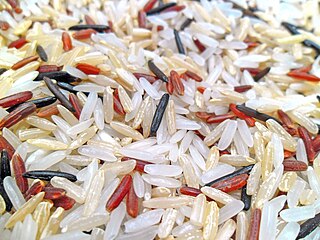
Rice is the seed of the grass species Oryza sativa or less commonly Oryza glaberrima. The name wild rice is usually used for species of the genera Zizania and Porteresia, both wild and domesticated, although the term may also be used for primitive or uncultivated varieties of Oryza.

Glutinous rice is a type of rice grown mainly in Southeast and East Asia, Northeastern India and Bhutan which has opaque grains, very low amylose content, and is especially sticky when cooked. It is widely consumed across Asia.

Brown rice is a whole grain rice with the inedible outer hull removed. This kind of rice sheds its outer hull or husk but the bran and germ layer remain on, constituting the brown or tan colour of rice. White rice is the same grain without the hull, the bran layer, and the cereal germ. Red rice, gold rice, and black rice are all whole rices with differently pigmented outer layers.

White rice is milled rice that has had its husk, bran, and germ removed. This alters the flavor, texture and appearance of the rice and helps prevent spoilage, extend its storage life, and makes it easier to digest. After milling (hulling), the rice is polished, resulting in a seed with a bright, white, shiny appearance.
Wheat flour is a powder made from the grinding of wheat used for human consumption. Wheat varieties are called "soft" or "weak" if gluten content is low, and are called "hard" or "strong" if they have high gluten content. Hard flour, or bread flour, is high in gluten, with 12% to 14% gluten content, and its dough has elastic toughness that holds its shape well once baked. Soft flour is comparatively low in gluten and thus results in a loaf with a finer, crumbly texture. Soft flour is usually divided into cake flour, which is the lowest in gluten, and pastry flour, which has slightly more gluten than cake flour.

The germ of a cereal is the reproductive part that germinates to grow into a plant; it is the embryo of the seed. Along with bran, germ is often a by-product of the milling that produces refined grain products. Cereal grains and their components, such as wheat germ oil, rice bran oil, and maize bran, may be used as a source from which vegetable oil is extracted, or used directly as a food ingredient. The germ is retained as an integral part of whole-grain foods. Non-whole grain methods of milling are intended to isolate the endosperm, which is ground into flour, with removal of both the husk (bran) and the germ. Removal of bran is aimed at producing a flour with a white rather than a brown color, and eliminating fiber, which reduces nutrition. The germ is rich in polyunsaturated fats and so germ removal improves the storage qualities of flour.
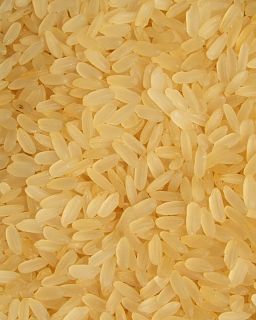
Parboiled rice is rice that has been partially boiled in the husk. The three basic steps of parboiling are soaking, steaming and drying. These steps make the rice easier to process by hand, while also boosting its nutritional profile, changing its texture, and making it more resistant to weevils. The treatment is practiced in many parts of the world.

Bhutanese red rice is a medium-grain rice grown in the Kingdom of Bhutan in the eastern Himalayas. It is the staple rice of the Bhutanese people.
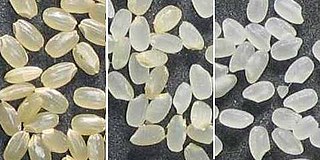
Japanese rice refers to a number of short-grain cultivars of Japonica rice including ordinary rice (uruchimai) and glutinous rice (mochigome).

Rolled oats are a type of lightly processed whole-grain food. Traditionally, they are made from oat groats that have been dehusked and steamed, before being rolled into flat flakes under heavy rollers and then stabilized by being lightly toasted.

Jasmine rice is a long-grain variety of fragrant rice. Its fragrance, reminiscent of pandan and popcorn, results from the rice plant's natural production of aroma compounds, of which 2-acetyl-1-pyrroline is the most salient. This rapid loss of aromatic intensity leads many Southeast Asians and connoisseurs to prefer each year's freshly harvested "new crop" of jasmine rice. Jasmine rice is a variety of Oryza sativa.
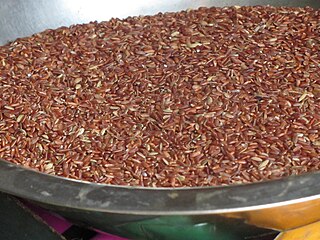
Red rice is a variety of rice that is colored red by its anthocyanin content. It is usually eaten unpolished or partially polished, and has a red bran layer, rather than the more common pale brown. Red rice has a nutty flavor. It has the highest nutritional value among rices eaten with the bran intact.. Some red rice has a low glycemic index. The rice will be slowly digested and energy will be slowly released. This will cause a slower increase in blood sugar levels. Red rice contains high antioxidant levels that reduce free radicals in the organism. It is also a richer source of iron, magnesium, calcium and zinc than white rice.

Pla ra, similar to padaek in Laos, is a traditional Thai seasoning produced by fermenting fish with rice bran or roasted rice flour and salt fermented in a closed container for at least six months. Fermented fish seasoning are commonly found in Cambodian, Lao, Mon, Thai and Vietnamese cuisine. Pla ra has a very strong smell, which is considered unpleasant by some people. Its flavors are salty and sour, depending on the amount of salt put in and lactic acid resulting from fermentation process.

Broken rice is fragments of rice grains, broken in the field, during drying, during transport, or during milling. Mechanical separators are used to separate the broken grains from the whole grains and sort them by size.
Instant rice is a product in which white rice is partially precooked, dehydrated, and repackaged in dried form similar in appearance to regular white rice. That process allows the product to be later cooked as if it were normal rice but with a typical cooking time of 5 minutes, compared to the 20-30 minute preparation time for white rice. This process was invented by Ataullah K. Ozai‐Durrani in 1939 and mass marketed by General Foods starting in 1946 as Minute Rice, a brand which continues until this day.
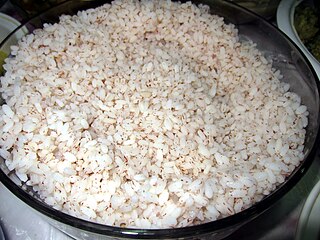
RoseMatta rice is an indigenous variety of rice grown in the Palakkad district of Kerala, India. It is known for its coarseness and health benefits. It is popular in Kerala and coastal Karnataka in India and Sri Lanka where it is used on a regular basis for idlies, appams and plain rice; it is different from brown rice. The robust and earthy flavour of Red Matta makes it suitable to accompany lamb, beef or game meats.

Rice-cooking utensils are tools used for cooking rice and similar foods.

Riceberry is a rice variety from Thailand, a cross-breed of Jao Hom Nin and Khao Dawk Mali 105. The variety was created in 2002 by the Rice Science Center, Kasetsart University, Thailand. The outcome is a soft, deep purple whole grain rice. Riceberry has been used a brown rice substitute. In 2005, it was approved for mass cultivation and consumption.



















